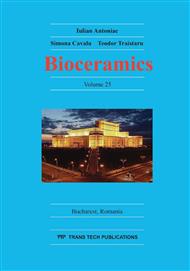[1]
J.T. To, S.M. Howell, M.L. Hull, Contributions of femoral fixation methods to the stiffness of anterior cruciate ligament replacements at implantation, Arthroscopy 15 (1999) 379-387.
DOI: 10.1016/s0749-8063(99)70055-1
Google Scholar
[2]
M. Suchenski, M.B. McCarthy, D. Chowaniec, D. Hansen, W. McKinnon, J. Apostolakos, R. Arciero, A.D. Mazzocca, Material properties and composition of soft-tissue fixation. Arthroscopy 26/6 (2010) 821-831.
DOI: 10.1016/j.arthro.2009.12.026
Google Scholar
[3]
S.L. Woo, J.M. Hollis, D.J. Adams, R.M. Lyon, S. Takai, Tensile properties of the human femur-anterior cruciate ligament-tibia complex. The effects of specimen age and orientation, Am J Sports Med. 19 (1991) 217-225.
DOI: 10.1177/036354659101900303
Google Scholar
[4]
J.F. Wilcox, J.A. Gross, R. Sibel, R.A. Backs, C.C. Kaeding, Anterior cruciate ligament reconstruction with hamstring tendons and cross-pin femoral fixation compared with patellar tendon autografts, Arthroscopy 21 (2005) 1186–1192.
DOI: 10.1016/j.arthro.2005.07.003
Google Scholar
[5]
A. Harilainen, J. Sandelin, K.A. Jansson, Cross-pin femoral fixation versus metal interference screw fixation in anterior cruciate ligament reconstruction with hamstring tendons: results of a controlled prospective randomized study with 2-year follow-up, Arthroscopy 21 (2005).
DOI: 10.1016/j.arthro.2004.09.013
Google Scholar
[6]
C. Fabbriciani, G. Milano, P.D. Mulas, F. Ziranu, G. Severini, Anterior cruciate ligament reconstruction with doubled semitendinosus and gracilis tendon graft in rugby players, Knee Surg Sports Traumatol Arthrosc. 13 (2005) 2–7.
DOI: 10.1007/s00167-004-0505-9
Google Scholar
[7]
E.M. Wolf, Hamstring anterior cruciate ligament reconstruction using femoral cross-pin fixation, Oper Tech Sports Med. 7 (1999) 214–222.
DOI: 10.1016/s1060-1872(99)80028-8
Google Scholar
[8]
W.J. Ciccone, C. Motz, C. Bentley, J.P. Tasto, Bioabsorbable implants in orthopaedics: new developments and clinical applications, J Am Assoc Orthop Surg. 9 (2001) 280–288.
DOI: 10.5435/00124635-200109000-00001
Google Scholar
[9]
V. Martinek, C. Lattermann, S.C. Watkins, F.H. Fu, The fate of the poly-L-lactic acid interference screw after anterior cruciate ligament reconstruction, Arthroscopy 17 (2001) 73–76.
DOI: 10.1053/jars.2001.7797
Google Scholar
[10]
C.B. Ma, K. Francis, J. Towers, J. Irrgang, F.H. Fu, C.H. Harner, Hamstring anterior cruciate ligament reconstruction: A comparison of bioabsorbable interference screw and EndoButton-post fixation, Arthroscopy 20 (2004) 122-128.
DOI: 10.1016/j.arthro.2003.11.007
Google Scholar
[11]
M.J. Radford, J. Noakes, J. Read, D.G. Wood, The natural history of a bioabsorbable interference screw used for anterior cruciate ligament reconstruction with a 4-strand hamstring technique. Arthroscopy 21(2005) 707-710.
DOI: 10.1016/j.arthro.2005.03.005
Google Scholar
[12]
G. Lajtai, G. Schmiedhuber, F. Unger, G. Aitzetmüller, M. Klein, I. Noszian, E. Orthner, Bone tunnel remodeling at the site of biodegradable interference screws used for anterior cruciate ligament reconstruction: 5-year follow-up, Arthroscopy 17 (2001).
DOI: 10.1053/jars.2001.21535
Google Scholar
[13]
J.C. Knowles, G.W. Hastings, H. Ohta, S. Niwa, N. Boeree, Development of a degradable composite for orthopaedic use: in vivo biomechanical and histological evaluation of two bioactive degradable composites based on the polyhydroxybutyrate polymer, Biomaterials 13/8 (1992).
DOI: 10.1016/0142-9612(92)90099-a
Google Scholar
[14]
N.L. Jones, D.F. Williams Poly [L-Lactide] and Poly[L-Lactide] Ceramic filled Composites: A Long Term in-vivo / in-vitro Degradation Study, Fifth World Biomaterials Congress. Volume Volume 2. Toronto, Canada: University of Toronto Press, (1996).
Google Scholar
[15]
W.H. Warden, D. Chooljian, D.W. Jackson, Ten-year magnetic resonance imaging follow-up of bioabsorbable poly-L-lactic acid interference screws after anterior cruciate ligament reconstruction, Arthroscopy 24 (2008) 370. e1-3.
DOI: 10.1016/j.arthro.2006.12.032
Google Scholar
[16]
T.L. Berg, L.E. Paulos, Endoscopic ACL reconstruction using Stryker Biosteon cross-pin femoral fixation and interlock cross-pin tibial fixation, Surg Technol Int. 12 (2004) 239-244.
DOI: 10.1016/b978-1-4160-3834-4.10037-x
Google Scholar
[17]
A. Espejo-Baena, F. Ezquerro, A.P. de la Blanca, J. Serrano-Fernandez, F. Nadal, E. Montanez-Heredia, Comparison of initial mechanical properties of 4 hamstring graft femoral fixation systems using nonpermanent hardware for anterior cruciate ligament reconstruction: an in vitro animal study, Arthroscopy 22/4 (2006).
DOI: 10.1016/j.arthro.2005.09.021
Google Scholar
[18]
I. Antoniac, D. Laptoiu, D. Popescu, Development of Bioabsorbable Interference Screws: How Biomaterials Composition and Clinical and Retrieval Studies Influence the Innovative Screw Design and Manufacturing Processes, (2012).
DOI: 10.1007/978-1-4614-4328-5_6
Google Scholar
[19]
M. Lind, J. Feller, K.E. Webster, Tibial bone tunnel widening is reduced by polylactate/hydroxyapatite interference screws compared to metal screws after ACL reconstruction with hamstring grafts, Knee 16/9 (2009) 447-451.
DOI: 10.1016/j.knee.2009.04.003
Google Scholar
[20]
M. Johnston, A. Morse, J. Arrington, M. Pliner, S. Gasser, Resorption and remodeling of hydroxyapatite-poly-L-lactic acid composite anterior cruciate ligament interference screws, Arthroscopy 27/12 (2011) 1671-1678.
DOI: 10.1016/j.arthro.2011.06.036
Google Scholar


